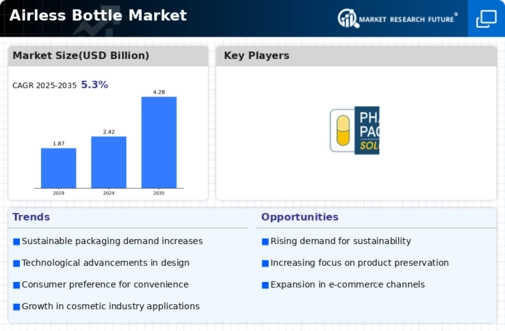Market Trends
Key Emerging Trends in the Airless Bottle Market
The beauty and personal care industry is driving considerable trends in the Airless Bottle Market. Cosmetic and skincare products are popularly packed in airless bottles, which shield delicate formulations from air and contaminants. The emphasis on product preservation and efficacy is one of the significant market trends for these containers. As a result of longer self-life and better functionality demands by consumers, beauty and personal care brands have embraced the use of airless bottles to maintain their formulas at the right condition for optimal performance.
The emerging trends affecting the market for airless bottles are customization and aesthetics. The significance that packaging plays as an integral part of complete product experience is now being realized by many brands. Customizable airless bottles can be colored, shaped or branded differently to make unique products with impressive appearances. This tendency complies with contemporary consumers’ desire to buy items that look nice packed inside thereby increasing popularly of this type of packing as a whole.
Airless Bottles market trend has been attributed to sustainability drive. Various industries including beauty industry have embarked on looking for eco-friendly packaging options, hence leading to an increased focus on environmental responsibility among them. As such Airless bottles reduce wastage since consumers can use all parts of the product without exposing it to oxygen which may cause spoilage thereby indirectly promoting sustainable goals. In addition, materials used in making these containers are becoming more recyclable/eco-friendly due to various reasons including shift towards green packaging practices across sectors
This market is experiencing major shifts because of e-commerce whose peculiarities necessitate specific approaches towards its packaging solutions. Moreover, they serve as leak-proof packages which cannot be tampered with while in transit thus ensuring no loss of content during transportation process which would otherwise make customers concerned about safety their products into hands of carriers as well as dropping number users opting Airless Bottles in e-commerce category.
Technological advancements are highly responsible for shaping trends within this sector because they have been used to improve the functionality of airless bottles. The functionalities and user experience of airless bottles are being enhanced through innovations in dispensing systems and materials. Airless pumps, accurate dosing mechanisms, improved barrier materials are some of the features that make these packages more reliable and easier to use in general. Brands are leveraging on such technological advancements for purposes of differentiating their products from those of rivals as well as satisfying the changing needs of customers.
Collaborations and partnerships along the supply chain are becoming a prominent trend in the airless bottle market. Packaging manufacturers collaborate with beauty brands and formulation experts to develop customized solutions for specific beauty products using airless bottles. This sort of collaboration ensures that these bottles do not just serve their function but also look good as per what each beauty product demands.
Nevertheless, there still remain challenges like cost factor which is one of them; education and awareness for both buyers and sellers against this type packaging were also mentioned amongst barriers why this innovation has not gained wider acceptance yet. Although this kind of packing offers much more benefits than other traditional ones, it is normally charged very high during initial installation stage as compared to others alternatives. Educating both consumers and brands about benefits linked with introduction if Airless Bottles involving product preservation, sustainability or even convenience when using them will be so important if resistance is to be overcome thus ensuring wide spread uptake.





Leave a Comment